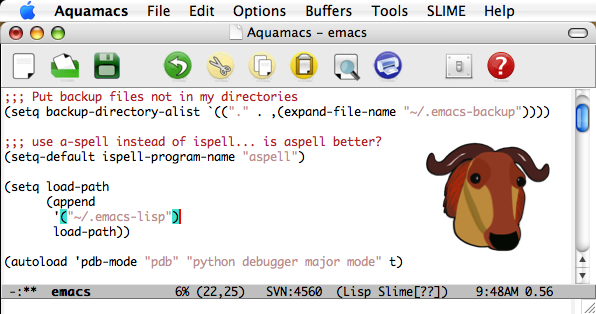

In Emacs, instead, that button marks a region ("selection"), with a second click in the same spot yanking ("cutting") the selected text. The situation with mouse behavior is similar as several participants in the discussion pointed out, users of graphical interfaces have come to expect that a right-button click will produce a menu of available actions. It is unfortunate that the people who implemented the newer editors chose incompatibility with Emacs. It would create a different editor that we Emacs users would never switch to. It is not an option to change these basic key bindings to imitate other, newer editors. That, of course, would break the finger memory of large numbers of existing Emacs users, who would be unlikely to appreciate the disruption. Many participants in the discussion said that this mode should be on by default.
#Aquamacs debug mode how to#
These bindings are easily had by turning on the Cua mode, but new users tend not to know about this mode or how to enable it. On the keyboard side, users have come to expect certain actions from certain keystrokes ^X to cut a selection, ^V to paste it, etc. From that, a proper theme engine could be supported, making dark themes and such easily available to those who want them.Īnother area where Emacs is insufficiently "modern", it seems, has to do with keyboard and mouse bindings. But there does seem to be general agreement that Emacs could benefit from a better, more centralized approach to color themes, rather than having color names hard-coded throughout various Elisp packages. (The latter is a rather noticeable indicator that debug mode had been accidentally left on.LWN.net re-visits the emacs-devel mailing list, where the Emacs 28 development cycle has revived discussions about how to make the text editor more "modern" and attractive to new users:Ī default dark theme may not be in the future, leading one to think that there may yet be hope for the world in general. To aid the person doing the debugging, all traps are made visible while debug mode is on, and those triggers that are normally hidden are shown as yellow shapes on the ground.
#Aquamacs debug mode plus#
In addition, hitting the period (.) key while in this mode calls up the "Chooser" window of the DM client, allowing the player to manipulate creatures, encounters, triggers, and waypoints.įurthermore, the plus key (+) can be used to instantly move the player's character to wherever the mouse cursor is pointing (provided it is pointing to a surface on which a creature can walk). Most commonly, this mode is used to access the DM console commands.

When debug mode is active, a player gains some abilities normally reserved for Dungeon Masters (DMs). ini file setting to be changed, but this is not the case in more recent versions. Very early versions of the game also required an. (In most cases, a multiplayer game can be debugged by a Dungeon Master with no need to explicitly turn on this mode.) This mode is entered by issuing the console command DebugMode 1 As a matter of habit, debug mode should be canceled as soon as it is no longer needed.ĭebug mode is normally only available in single-player games. Important: Playing in debug mode can cause stability problems, particularly if the game is saved while debug mode is active. This mode, as the name implies, was created to enable the game (or a module) to be checked for bugs.

Debug mode is a state the Neverwinter Nights client can be put in that enables a player to manipulate the game in ways not normally allowed (called "cheating" by some).


 0 kommentar(er)
0 kommentar(er)
